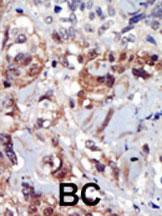PIP5K2 Alpha (PIP5K2A) Antibody (C-term)
Purified Rabbit Polyclonal Antibody (Pab)
- 产品详情
- 文献引用 : 5
- 实验流程
- 背景知识
Application
| WB, IHC-P, E |
|---|---|
| Primary Accession | P48426 |
| Other Accession | Q9R0I8, O13010, O70172, NP_005019 |
| Reactivity | Human |
| Predicted | Mouse, Pig, Rat |
| Host | Rabbit |
| Clonality | Polyclonal |
| Isotype | Rabbit IgG |
| Calculated MW | 46225 Da |
| Antigen Region | 303-335 aa |
| Gene ID | 5305 |
|---|---|
| Other Names | Phosphatidylinositol 5-phosphate 4-kinase type-2 alpha, 1-phosphatidylinositol 5-phosphate 4-kinase 2-alpha, Diphosphoinositide kinase 2-alpha, PIP5KIII, Phosphatidylinositol 5-phosphate 4-kinase type II alpha, PI(5)P 4-kinase type II alpha, PIP4KII-alpha, PtdIns(4)P-5-kinase B isoform, PtdIns(4)P-5-kinase C isoform, PtdIns(5)P-4-kinase isoform 2-alpha, PIP4K2A, PIP5K2, PIP5K2A |
| Target/Specificity | This PIP4K2 Alpha (PIP4K2A) antibody is generated from rabbits immunized with a KLH conjugated synthetic peptide between 303-335 amino acids from the C-terminal region of human PIP4K2 Alpha (PIP4K2A). |
| Dilution | WB~~1:1000 IHC-P~~1:100~500 E~~Use at an assay dependent concentration. |
| Format | Purified polyclonal antibody supplied in PBS with 0.09% (W/V) sodium azide. This antibody is prepared by Saturated Ammonium Sulfate (SAS) precipitation followed by dialysis against PBS. |
| Storage | Maintain refrigerated at 2-8°C for up to 2 weeks. For long term storage store at -20°C in small aliquots to prevent freeze-thaw cycles. |
| Precautions | PIP5K2 Alpha (PIP5K2A) Antibody (C-term) is for research use only and not for use in diagnostic or therapeutic procedures. |
| Name | PIP4K2A (HGNC:8997) |
|---|---|
| Function | Catalyzes the phosphorylation of phosphatidylinositol 5- phosphate (PtdIns5P) on the fourth hydroxyl of the myo-inositol ring, to form phosphatidylinositol 4,5-bisphosphate (PtdIns(4,5)P2) (PubMed:23326584, PubMed:9367159). Has both ATP- and GTP-dependent kinase activities (PubMed:26774281). May exert its function by regulating the levels of PtdIns5P, which functions in the cytosol by increasing AKT activity and in the nucleus signals through ING2 (PubMed:18364242). May regulate the pool of cytosolic PtdIns5P in response to the activation of tyrosine phosphorylation (By similarity). Required for lysosome-peroxisome membrane contacts and intracellular cholesterol transport through modulating peroxisomal PtdIns(4,5)P2 level (PubMed:29353240). In collaboration with PIP4K2B, has a role in mediating autophagy in times of nutrient stress (By similarity). Required for autophagosome-lysosome fusion and the regulation of cellular lipid metabolism (PubMed:31091439). May be involved in thrombopoiesis, and the terminal maturation of megakaryocytes and regulation of their size (By similarity). Negatively regulates insulin signaling through a catalytic-independent mechanism (PubMed:31091439). PIP4Ks interact with PIP5Ks and suppress PIP5K-mediated PtdIns(4,5)P2 synthesis and insulin-dependent conversion to PtdIns(3,4,5)P3 (PubMed:31091439). |
| Cellular Location | Cell membrane {ECO:0000250|UniProtKB:O70172}. Nucleus. Lysosome {ECO:0000250|UniProtKB:O70172}. Cytoplasm. Photoreceptor inner segment {ECO:0000250|UniProtKB:O70172}. Cell projection, cilium, photoreceptor outer segment {ECO:0000250|UniProtKB:O70172}. Note=May translocate from the cytosol to the cell membrane upon activation of tyrosine phosphorylation. May translocate from the inner to the outer segments of the rod photoreceptor cells in response to light (By similarity) Localization to the nucleus is modulated by the interaction with PIP4K2B. {ECO:0000250|UniProtKB:O70172, ECO:0000269|PubMed:20583997} |
| Tissue Location | Expressed ubiquitously, with high levels in the brain. Present in most tissues, except notably skeletal muscle and small intestine. |
For Research Use Only. Not For Use In Diagnostic Procedures.

Provided below are standard protocols that you may find useful for product applications.
BACKGROUND
Phosphatidylinositol-4,5-bisphosphate, the precursor to second messengers of the phosphoinositide signal transduction pathways, is thought to be involved in the regulation of secretion, cell proliferation, differentiation, and motility. TPIP5K2A is one of a family of enzymes capable of catalyzing the phosphorylation of phosphatidylinositol-4-phosphate on the fifth hydroxyl of the myo-inositol ring to form phosphatidylinositol-4,5-bisphosphate. The amino acid sequence of this enzyme does not show homology to other kinases, but the recombinant protein does exhibit kinase activity. The protein is a member of the phosphatidylinositol-4-phosphate 5-kinase family.
REFERENCES
Rozenvayn, N., et al., J. Biol. Chem. 278(10):8126-8134 (2003).
Boronenkov, I.V., et al., J. Biol. Chem. 270(7):2881-2884 (1995).
Loijens, J.C., et al., Adv. Enzyme Regul. 36, 115-140 (1996).
Divecha, N., et al., Biochem. J. 309 (Pt 3), 715-719 (1995).
终于等到您。ABCEPTA(百远生物)抗体产品。
点击下方“我要评价 ”按钮提交您的反馈信息,您的反馈和评价是我们最宝贵的财富之一,
我们将在1-3个工作日内处理您的反馈信息。
如有疑问,联系:0512-88856768 tech-china@abcepta.com.






















 癌症的基本特征包括细胞增殖、血管生成、迁移、凋亡逃避机制和细胞永生等。找到癌症发生过程中这些通路的关键标记物和对应的抗体用于检测至关重要。
癌症的基本特征包括细胞增殖、血管生成、迁移、凋亡逃避机制和细胞永生等。找到癌症发生过程中这些通路的关键标记物和对应的抗体用于检测至关重要。 为您推荐一个泛素化位点预测神器——泛素化分析工具,可以为您的蛋白的泛素化位点作出预测和评分。
为您推荐一个泛素化位点预测神器——泛素化分析工具,可以为您的蛋白的泛素化位点作出预测和评分。 细胞自噬受体图形绘图工具为你的蛋白的细胞受体结合位点作出预测和评分,识别结合到自噬通路中的蛋白是非常重要的,便于让我们理解自噬在正常生理、病理过程中的作用,如发育、细胞分化、神经退化性疾病、压力条件下、感染和癌症。
细胞自噬受体图形绘图工具为你的蛋白的细胞受体结合位点作出预测和评分,识别结合到自噬通路中的蛋白是非常重要的,便于让我们理解自噬在正常生理、病理过程中的作用,如发育、细胞分化、神经退化性疾病、压力条件下、感染和癌症。







